Complete Solutions to PROBLEMS FOR PRACTICE of chapter BASIC PRINCIPLES OF ORGANIC COMPOUNDS (MECHANISM OF ORGANIC REACTIONS) of Class 12 book with complete answers and questions
| Class 12 | CHEMISTRY |
| Chapter | BASIC PRINCIPLES OF ORGANIC COMPOUNDS (MECHANISM OF ORGANIC REACTIONS) |
| OP TANDON | PROBLEMS FOR PRACTICE |
| Number Of Questions | 17 |
| Academic Year | 2023-24 |
Classify the following into electrophilic and nucleophilic reagents:
(a)`H^(+)" (b) " Cl^(-)" (d) " NH_(3)" (d)"NO_(2)^(+)" (e)"Cbar(N)" (f)"H_(2)O`
`"(g) "Br^(+)" (h)"ROH" (i)"BF_(3)" (j)"RNH_(2)" (k)"AlCl_(3)`
`"(l) "ROR" (m) Carbocations (n) Carbanions (o) "SO_(3)H`
`"(p) "BeCl_(2)" (q) "I^(-)" (r) "SnCl_(4)" (s)":"CCl"_(2)" (t) ":P(CH_(3))_(3)`
`(u) H_(2)C=CH_(2)`
(B) Classify the following as Lewis acids and Lewis bases : `(a)CH_(3)NH_(2)" (b)"CN^(-)" (c)"AlCl_(3)" (d)"Fe^(3+)" (e) "CO_(2)^(-)`
View SolutionFor the following bond cleavages, use curved arrows to show the electron flow and classify each as homolysis or heterolysis. Identify reactive intermediate produced during the fission.
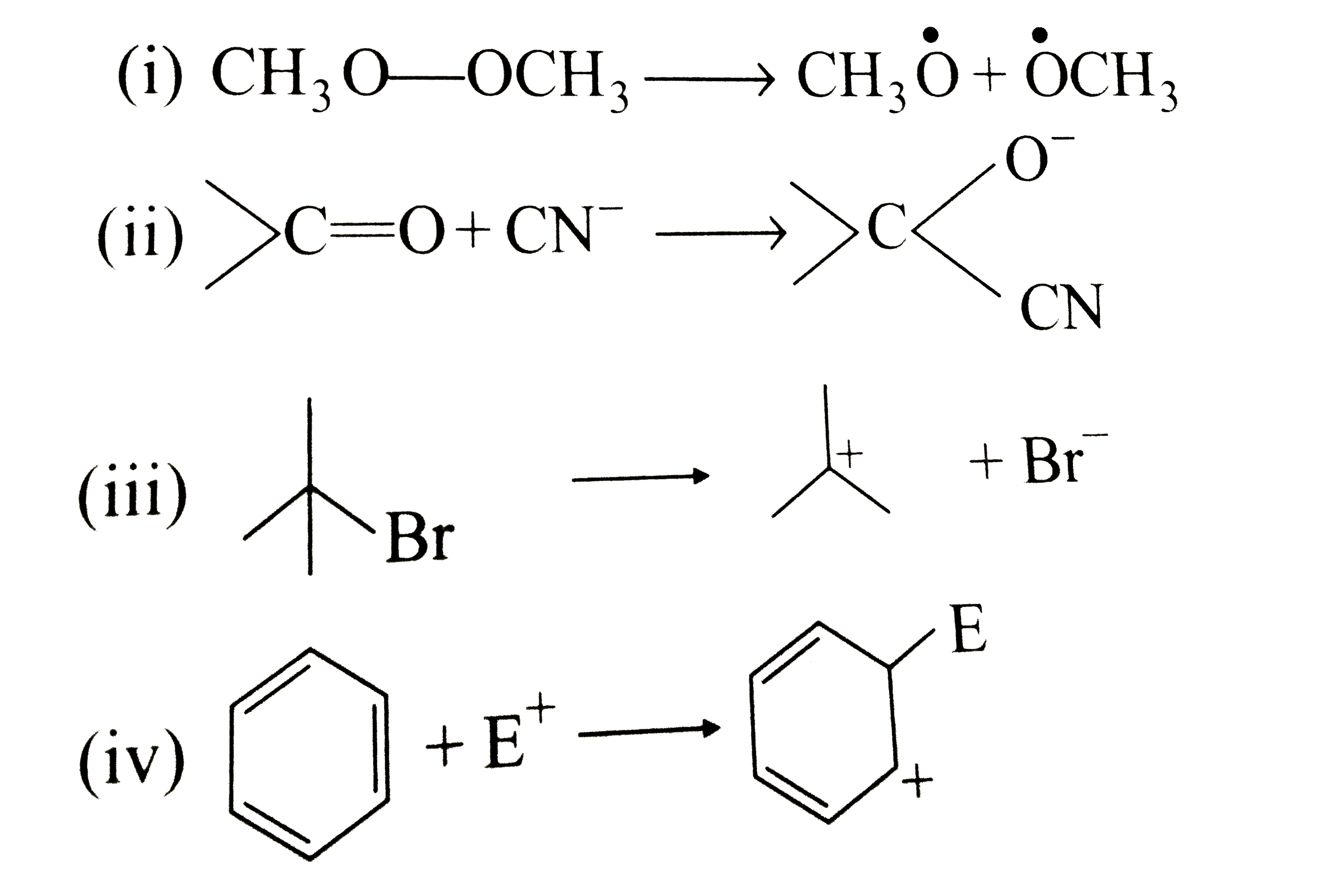
View SolutionIdentify each of the following as carbon-intermediates:
`{:((a)CH_(3)-CH=overset(+)CH,(b)(CH_(3))_(3)overset(.)C),((c)(CH_(3))_(3)bar(C),(d)C_(2)H_(5)overset(.)"CC"H_(3)),((e)CH_(3)-bar(C)H-CH_(3),(d)C_(2)H_(5)overset(.)"C"CH_(3)),((e)CH_(3)-bar(C)H-CH_(3),(f)C_(2)H_(5)overset(..)C-H),((g)C_(6)H_(5)-overset(..)underset(..)N,(h):"CCl"_(2)):}`
View SolutionClasssify the following reactions by type:


View SolutionArrange the following according to their stability:
`CH_(3)CH_(2)CH_(2)overset(+)CH_(2),(CH_(3))_(3)overset(+)C,CH_(3)CH_(2)overset(+)CH_(2),`
`CH_(3)CH_(2)overset(+)CHCH_(3),CH_(3)overset(+)CH_(2),overset(+)CH_(3)`
(b) Arrange the following according to their stability:
`C_(6)H_(5)overset(-)CH_(2),(CH_(3))_(3)overset(-)C,overset(-)"C"Cl_(3),overset(-)CH_(3),(CH_(3))_(2)overset(-)CH`
(c) Arrange the following according to their stability:
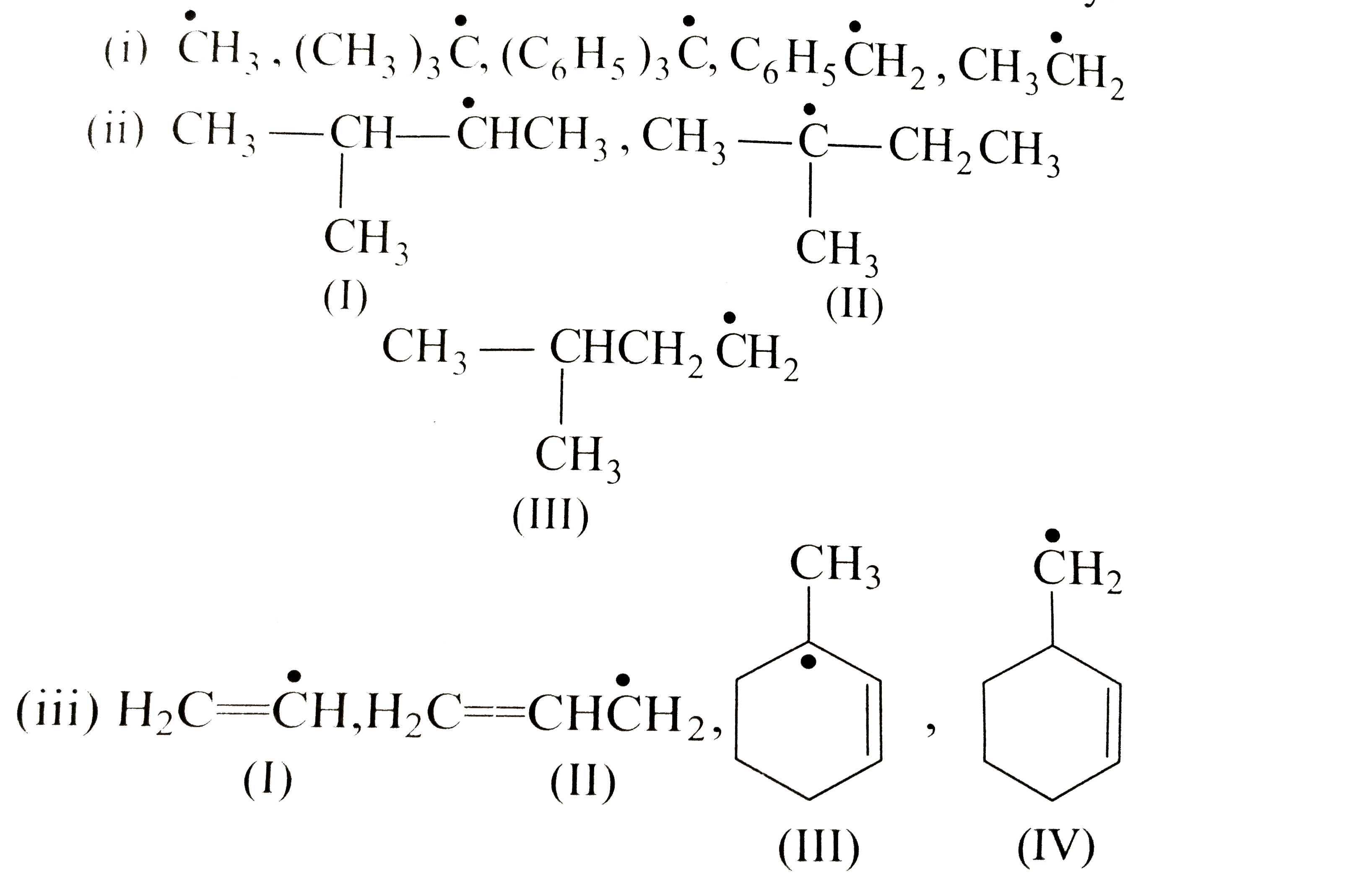
(d) Arrange the following in order of their :
(i) increasing basicity:
`H_(2)O,OH^(-),CH_(3)OH,CH_(3)O^(-)`
(ii) increasing reactivity in nucleophilic substitution reaction: `CH_(3)F,CH_(3)I,CH_(3)Br,CH_(3)Cl`.
(iii) increasing order of expected enol content:
`CH_(3)COCH_(2)CHO," "CH_(3)COCH_(3)," "CH_(3)CHO,`
`CH_(3)COCH_(2)COCH_(3)`.
decreasing order of `S_(N^(2))` reactivity:
`RCH_(2)X,R_(2)CHX,R_(3)CX,MeX`.
(v) decreasing order of `S_(N^(1))` reactivity:
(i) 2-bromopentane (A), 1-bromopentane (B), 2-bromo-2-methylbutane (C).
(ii) 1-bromo-3-methylbutane(A),
2-bromo-2-met-hylbutane (B),
2-bromo-3-methylbutane(C)
(vi) decreasing order of `S_(N^(2))` reactivity:
1-bromobutane, (A), 1-bromo-2,2-dimethyl-propane (B), 1-bromo-2-methylbutane (C), 1-bromo-3-methylbutane (D).
(vii) decreasing order of `S_(N^(2))` reactivity in alkoxide nucleophiles:
`Me_(2)CHoverset(-)O,Me_(3)Coverset(-)O, MeCH_(2),overset(-)O,Meoverset(-)O`
(c) Arrange the following as stated:
(i) increasing order of acid strength:
`ClCH_(2)COOH,CH_(3)CH_(2)COOH,ClCH_(2)CH_(2)COOH,`
`(CH_(3))_(2)CHCOOH,CH_(3)COOH`
(ii) increasing order of acidity : `HClO,HCiO_(2),HClO_(3),HClO_(4)`
(iii) increasing strength of H-bonding `(X----H-X)`:
O, S, F, Cl, N
View SolutionAnswer the following :
(a) How many types of fission are possible of a covalent bond?
(b) how many types of ions are formed by heterolytic fission and what are their names?
(c) What are the names and nature of the parts formed by homolytic fission?
(d) How many electrons are present in the valence shell of the carbon atom of the carbonium ion?
(e) How many electrons are present in the valence shell of carbon atom of the carbanion ion?
(f) Name the attacking reagents and give their nature.
(g) Write the names of the parts obtained when `C-Cl` bond of ethyl chloride undergoes heterolytic fission.
(h) What is the major factor that influences the relatives stabilities of carbocations, carbanions and free radicals.
View SolutionExplain:
(i) Why trichloroacetic acid is stronger than acetic acid?
(ii) Why formic acid is stronger than butyric acid?
(iii) Why alkyl amines are stonger bases than ammonia?
(iv) Why benzyl carbocation is more stable than ethyl caebocation?
(v) What is the effect of introduction of an alkyl group or the stability of the carbocation?
(vi) Why allyl cation is more stabe than ethyl cation?
(vii) Why does tert-butyl chloride react with sodium hydroxide solution bt `S_(N^(1))` mechanism while n-butyl chloride react by `S_(N^(2))` mechanism?
(viii) In acylium ion, the structure `R-C-=overset(+)O:` is more stable than `R-overset(+)C=O`.
(ix) Why toluene reacts with bromine is presence of light gives benzyl bromide while in presence of `FeBr_(3)`, it gives p-bromotoluene?
(x) Why aryl halides are less reactive than alkyl halides towards nucleophilic reagents?
(xi) Draw the stereochemical structures of the products in the following reaction:

(xvii) Predict the relative yields of the product of `Me_(3)CBr` in `80%` EtOH and `20%H_(2)O`.
View SolutionComplete the following and identify the type for the inter-mediate species:
(a) `CH_(3)CH(OH)CH_(3)+H^(+)overset("Heat")rarr………+HOH`
(b) `CH_(3)-C-=C-H+Na^(+)NH_(2)^(-)rarr …….+Na^(+)+NH_(3)`
(c) `CH_(3)CH_(2)-N=N-CH_(2)CH_(3)overset("Heat")rarr......+N_(2)`
(d) `CH_(3)-CH=CH-CH_(3)+HIrarr ........+I^(-)`
(e) `CH_(3)CHI_(2)+Znrarr ........+ZnI_(2)`
(f) `CH_(3)CH_(2)Cl+AlCl_(3)rarr .....+AlCl_(4)`
View SolutionComplete the following and identify the type of displacement reactions:
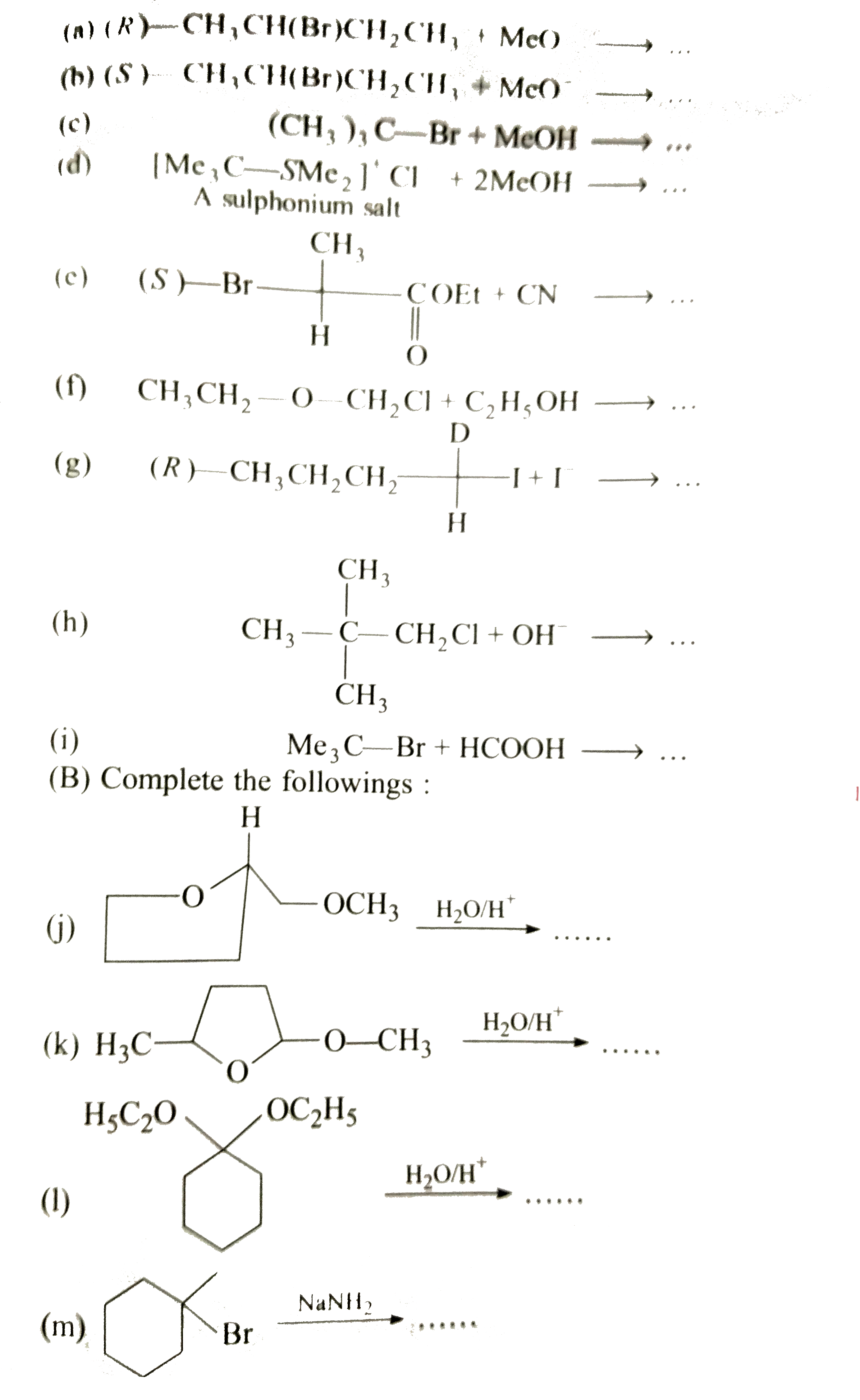
View SolutionComplete the following addition reactions through the intermediate formation of stable carbocation (A) :
(i) `CH_(3)-overset(CH_(3))overset("| ")"CH"-CH=CH_(2)overset(HCl)rarr(A)overset(Cl^(-))rarr(B)`
(ii) `CH_(3)-overset(CH_(3))overset("| ")underset(CH_(3))underset("| ")"C "-CH=CH_(2)overset(HCl)rarr(A)overset(Cl^(-))rarr(B)`
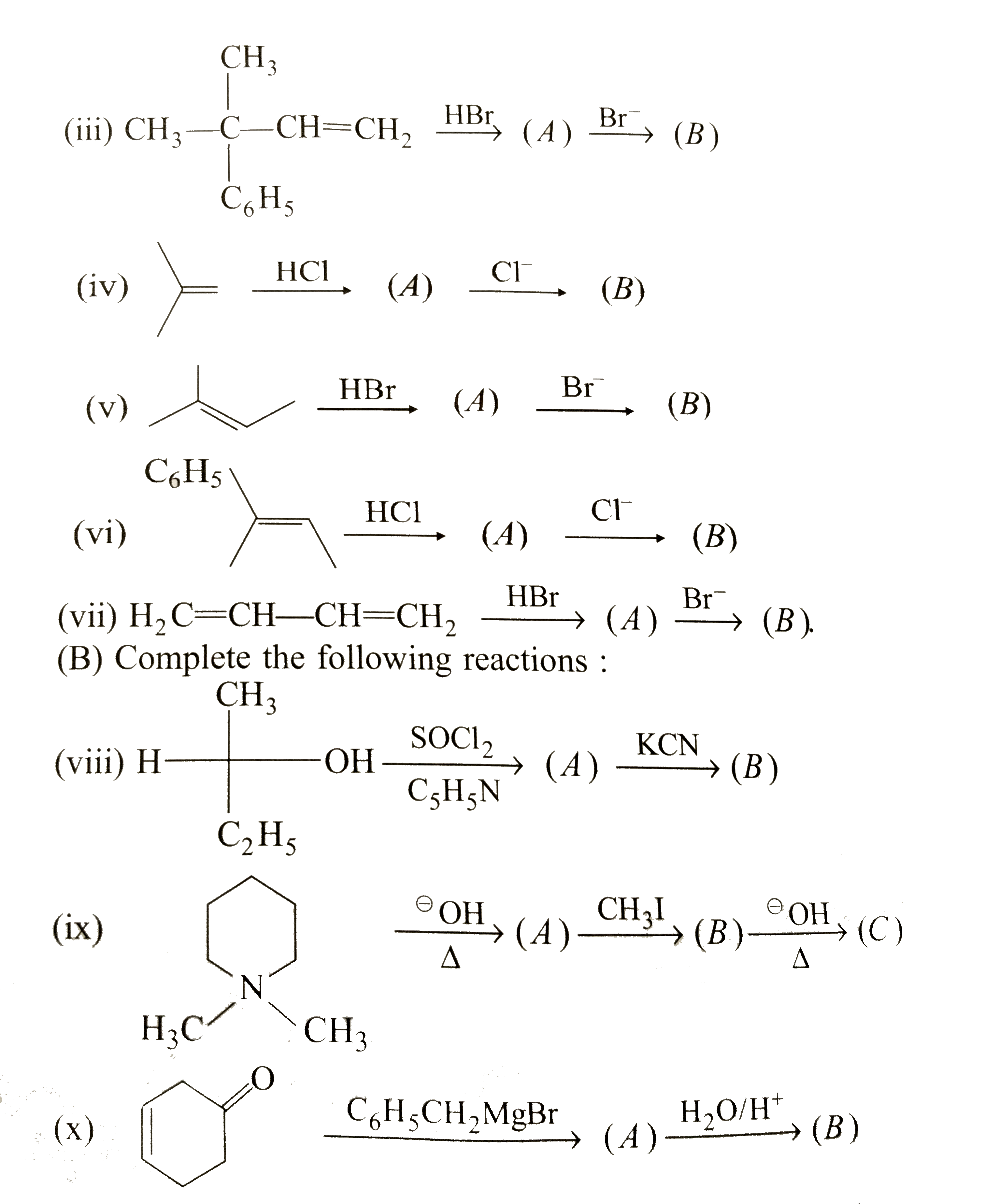
View SolutionWhat are the various alkanes obtained due to insertion when 2-methylbutane reacts with singlet methylene `( :CH_(2))`?
View SolutionSuggest a possible mechanism for the formation of `R-Li` from `R-X` by equation only.
View SolutionGive the major `E_(1)` product of the following reactions :
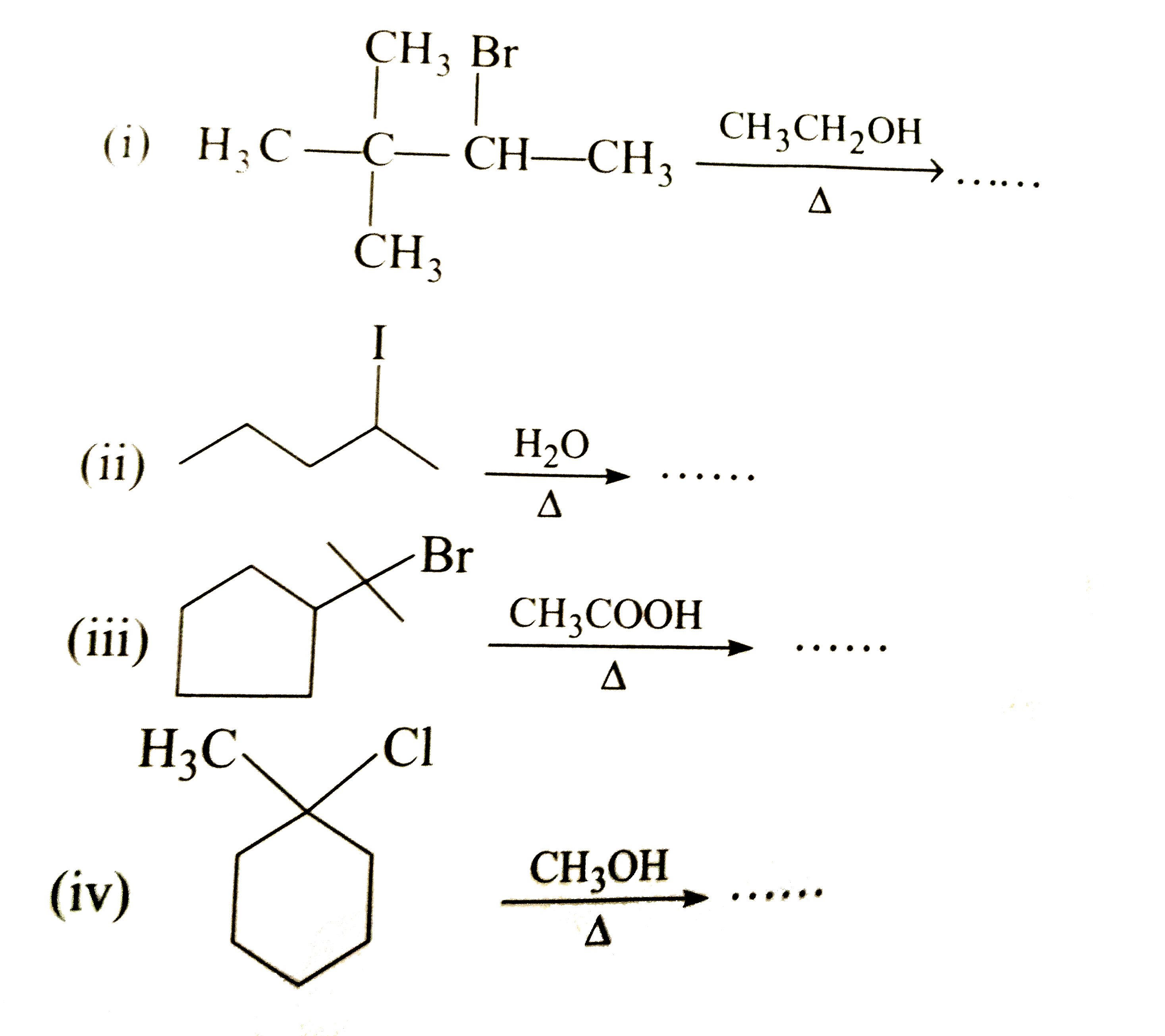
View SolutionGive possible mechanism of the given reaction using carbocation rearrangement.

View SolutionWhich the resonance structure of the following species :
(i) `:overset(-)CH_(2)-C-=N:`
(ii) `CH_(3)CH=CH-overset(+)CH-CH_(3)`
(iii) `overset(+)CH_(2)-CH=CH-overset(-)CH_(2)`
(iv) `CH_(3)-overset( :O: )overset(||)C-overset(-)underset(..)CH_(2)`
(B) Write resonance structure for the intermediate carbocation in the aromatic chlorination of benzene.
(C) Write the main resonance structure of the conjugate base of a 1, 3-diketone.
(D) Write the resonance structure of `CH_(2)=CH-CHO`. Indicate relative stability of the contributing structures.
View SolutionWhich one hydrolysis at a faster rate by `S_(N)1` mechanism?
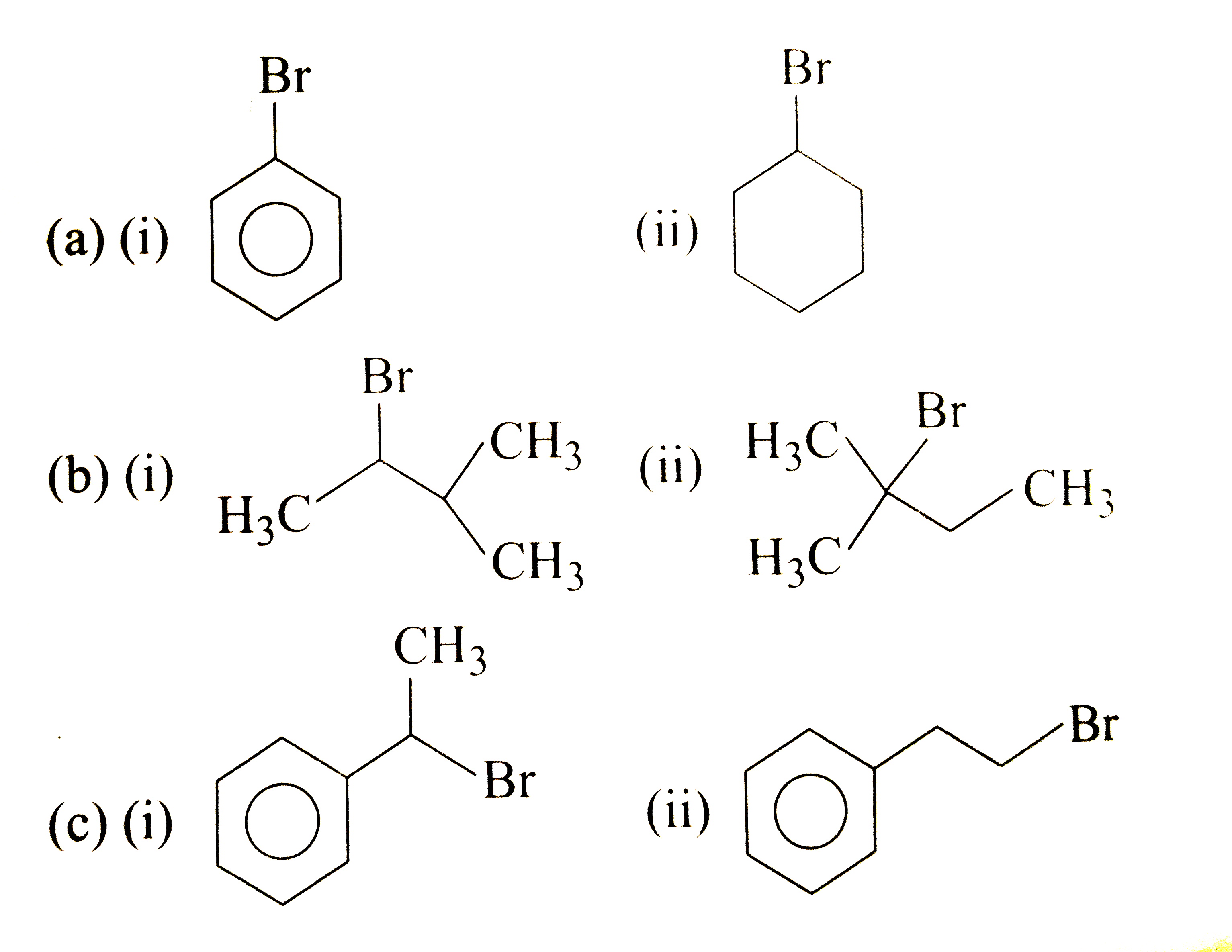
View SolutionMatch the following columns

View Solution
PROBLEMS FOR PRACTICE questions and complete solutions for chapter BASIC PRINCIPLES OF ORGANIC COMPOUNDS (MECHANISM OF ORGANIC REACTIONS) of G.R. BATHLA & SONS CHEMISTRY (HINGLISH) of Class 12
All Exercises from OP TANDON Class 12 CHEMISTRY BASIC PRINCIPLES OF ORGANIC COMPOUNDS (MECHANISM OF ORGANIC REACTIONS)
- ASSERTION-REASON TYPE QUESTIONS
- BRAIN STORMING PROBLEMS
- ILLUSTRATIONS OF OBJECTIVE QUESTIONS
- MATRIX-MATCH TYPE QUESTIONS
- OBJECTIVE QUESTIONS (Level-A)
- OBJECTIVE QUESTIONS (Level-B)
- PASSAGE-I
- PASSAGE-II
- PASSAGE-III
- PASSAGE-IV
- PASSAGE-V
- PROBLEMS FOR PRACTICE
- SET II
- SINGLE INTEGER ANSWER TYPE QUESTIONS
- SOME SOLVED PROBLEMS